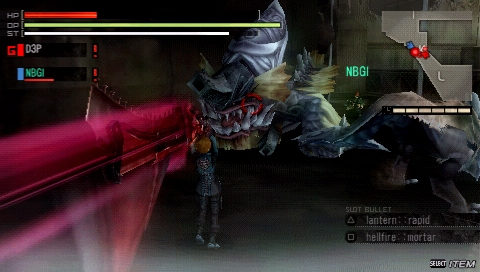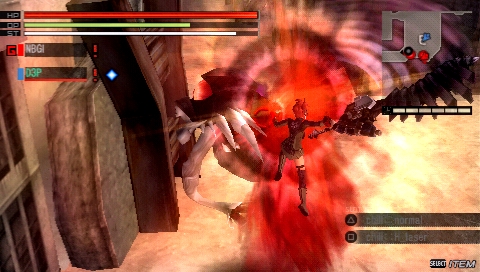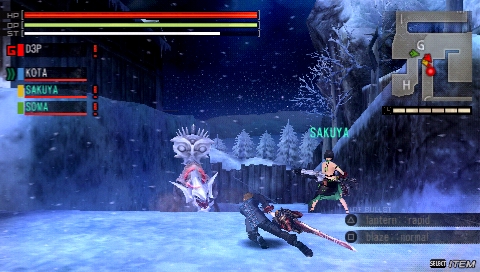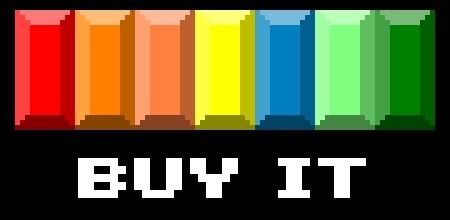
Gods Eater Burst is an action-adventure video game for the PSP, developed by Namco Bandai and published in the United States by D3 Publisher. It was released in 2010 in Japan and re-released later that year with improvements before being brought here. In a post-apocalyptic world, only the Gods Eaters and their weapons, the God Arcs, can destroy the Aragami, massive and quickly adaptive monsters that are devouring the entire world. With addictive gameplay, incredibly customizable equipment, unforgettable music, and a thrilling story, this game is almost gluttonous in how satisfying it can be. Add in a multiplayer mode and the experience becomes unbeatable.
Platforms: PSP
Publisher: D3 Publisher
Developer: Shift / Namco Bandai
Genre: Deity-Destroying Action-Adventure
Release Date: March 15, 2011
ESRB Rating: Teen
Gods Eater Burst is the kind of game portable gamers dream about. It’s got a solid, coherent storyline; gameplay that is satisfying and addicting while not falling into repetition; and a robust customization system. You’re immediately thrown into the inherent Japan-ness of the game from the start, with an introduction that feels more like an anime montage than the start of a video game. The first thing you do is build your character – male or female, eye and hair color, clothing, etc. I chose a girl with brown eyes, purple hair, and a crazy purple outfit. You know – my regular attire.
From there, you get your first taste of what’s going on in the story. You’re part of the Fenrir Far East Branch, and you are the newest Gods Eater. You’re a rookie, and as such you’re both looked down on as a newcomer and revered as the newest member of a brave organization. Your job is to destroy Aragami, giant and terrifying monsters made up of Oracle Cells. Aragami evolve at a lightning-fast pace, and consume everything around them, causing them to evolve into things they’ve consumed. For example, there’s one giant Aragami that has tank treads for legs and can fire missiles. As a new-type, you’re given your God Arc, attached to your arm by a bracelet that injects you with Oracle Cells, and if you survive, well, basically, you’re officially hired, and your hazing period is over.
Once you’re set up and you speak to a few other members of the branch – some also God Eaters like you – you are able to begin the tutorials. These are very basic introductions, explaining all of your main functions – how to use your blade and gun and switch between them, how to block with your shield, how to use your items (including grenades and power-ups), and other cool things, like maneuvers you can use while jumping and using your gun (shooting a bullet while jumping can propel you backwards and out of harm’s way).

But the real way to learn in this game is trial by fire, and your first missions – many of which make recommendations on optimal loadouts – teach you how to fight, survive, and ultimately succeed in your goal, which is to gather research to help rid the planet of these monsters. Of course, another goal is just to kill as many as you can. You have up to three AI allies in the battles – the number and who you get to use depends on the mission itself. Sometimes you have three and you can choose them; other times, you have one to three and they’re chosen for you.
Your NPCs are as important as your own character. Each one has different abilities, so be sure to pay attention and choose who would be the best fit for whatever mission you’re about to go on. Likewise, if your options for NPCs are limited, be sure to arm yourself for what they lack. Also, as you progress through the games and the missions get harder, it’s important to know when to keep your party together, and when to split them up to face the opposition separately and try to finish the mission within the allotted 30 minutes. You can also call your party back together, but be careful when doing this, because some Aragami are nearly impossible to destroy when they’re both fighting you at the same time. Employing strategies becomes imperative as the Difficulty levels ramp up.
One other major move that you employ constantly is called a “devour,” in which your blade comes to life in the form of a monster’s head and takes a bite out of the Aragami. Doing that while they’re alive gives you a “burst,” which gives you a “burst” bar that makes you faster, uses up your stamina less quickly, and allows you to do a double jump, giving you a height advantage. You also gain special bullets this way, which can be used against your enemies, or used to give your allies power-ups.
Devouring has another goal – use it when the enemy has been defeated, and you obtain special items for crafting and upgrading your equipment, as well as for creating items and new outfits. Materials can also be salvaged around the individual areas where you fight the Aragami, as well as purchased from a merchant within the Fenrir complex. Crafting in this game can become addictive – before I went out for every mission, I would arrange my equipment optimally against whatever I was fighting, and then go in and see if I had enough materials to craft anything better, or upgrade what I was already using. I also got into creating my own bullets, in which you can control many of the subtleties – how you want it to arc once you’ve shot it, how powerful you want it to be, if you want it to be a homing bullet, etc. The crafting options are intense and very fun.

Fighting the Aragami is overwhelming at first, as you have to very quickly adapt to their patterns and know when to fight and when to block. You use up your OP when you fire bullets, but gain it quickly with blade hits. Watch your stamina, which gets used up when you run and when you employ specific moves – once it’s out, your character will stand still for a few seconds, which is enough time to get wrecked by the fast-moving Aragami. Each one has different weaknesses, both in elements, blade types, and on their body. Some might be weak to fire and piercing attacks, while others require freezing and crushing weapons. You must also choose your armor carefully, as some shoot chunks of ice while others launch missiles and fireballs. Attack where the Aragami are weak, and try to unbound their Oracle Cells, which can stun them and open up new weak spots.
Missions progress in two ways – there are story missions and side quests, each with different Aragami and varying rewards. I initially did only the story missions, but once I got to Difficulty 6, I found myself stuck on one that was particularly difficult. I decided to go back to Difficulty 1 and start doing some side missions. These flew by quickly, and before I knew it, I’d finished all the side missions in the first 3 difficulties. I went back and was able to beat the story mission I’d been stuck on, thanks to the items I’d received and the new weapons I’d crafted – not to mention all of the additional practice it gave me in fighting Aragami. By the time I’d gotten to the end of the story, I’d finished all the side missions available, and beat the game in just under 50 hours.
The game itself – from opening to closing credits – goes from Difficulty 1 to Difficulty 6. But after that, there’s still more to finish, and the game goes all the way to Difficulty 10. The story that lies between the opening and closing is phenomenal. The character development, the story arc, the interweaving of the gameplay, and everything from both the story and side missions work together to make an incredible gaming experience.

But there’s still more, even beyond this, which is easily over 100 hours of gameplay. There’s also an option for multiplayer. In multiplayer, you join up to three other people – either locally or via AdHoc Party through the PlayStation 3 – to take on missions. This is a much different experience, because now, instead of playing with the sometimes-useless AI, you get to play with other people who are as into the game as you are. (In general, the AI is helpful, but there are times when they’re not – like if you’re sniping from far away, they sometimes gather around you stupidly, or the medics fail to heal you when you’re close to dying.) This brings another dimension to the game. You can only play up to the level of the lowest player – so if you’re at Difficulty 6 and everyone else is at 3, you’ll have to play at Difficulty 3.
Each member can get items from Aragami when they devour them, and there’s also the added bonus of picking up tickets. There are specific items that can only be obtained by trading in these tickets, so these items – and the subsequent weapons crafted with them – require multiplayer play if you want to get them. Also available in multiplayer is the ability to exchange your Avatar with other players and reap even more rewards. If you exchange Avatar Cards and another player opts to use your Avatar, you can then gain the same rewards (although the Difficulty level rule still applies – you can only gain items up to whichever Difficulty level you’ve achieved). There’s an additional option in the menu to trade your Avatar Card while in sleep mode as well.
To top off the awesomeness of this game is the great voice acting as well as the unbeatable score. The characters are brought to life through interactions inside and outside the facility, as well as through the cutscenes and the performances of the voice actors. The score, expertly done by Go Shiina, is unforgettable, elevating the suspense in certain scenes while motivating the fighters in others. Even the basic music that plays in the facility as you’re scrolling through menus is remarkable. The high production values on this game make it truly feel like you’re playing through an anime, especially with all of the intrigue and twists in the story.
There are some negatives to this game, but they’re not deal breakers. As is common in games where you can choose the gender of your character, most characters refer to you as “he” and “him” even if you choose to be a girl. It didn’t take me out of the story, though it did make me laugh several times. It would also be nice to have a meter of the enemy’s health, but once you start getting used to patterns, you’ll be able to tell as they get closer to death. One thing that wasn’t just an idle annoyance was the camera control. You move your character with the analog stick but rotate the camera with the directional buttons. This can be obnoxious and cumbersome when you’re in the midst of an intense battle. Options like locking on with your blade and pulling up crosshairs with your gun make this less annoying, but be prepared for more than few accidental moments where you smash the wrong button and the camera goes wildly in a direction you weren’t expecting.
Gods Eater Burst is an excellent game, and perfect for PSP owners who love something with intensity and a great story. Many games sacrifice a good storyline for amazing gameplay, or shoehorn in unnatural multiplayer elements to extend the life of the game. With Gods Eater Burst, you’re getting a phenomenal single-player experience as well as a robust multiplayer functionality. Everything you need comes wrapped in one package, replete with a very balanced challenge and a lot of satisfaction. While it would seem that 100 missions would eventually get repetitive, I was never once bored with a mission, and found I was constantly trying to improve and build on my techniques. This is a must-have game with a lot to offer portable gamers.

Review Disclosure: A review copy of Gods Eater Burst was provided by D3 Publisher for the purposes of this review.







